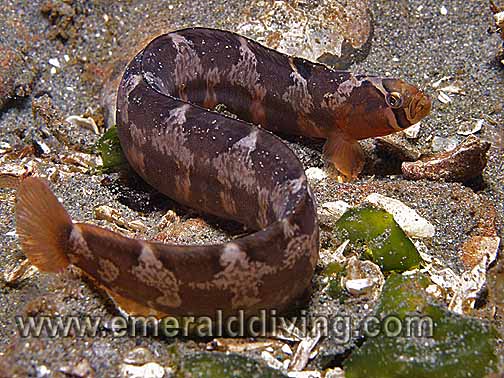
Pholis ornata
FAMILY
Pholidae
TAXONOMY
Gunnellus ornatus Girard, 1854, San Francisco, California.
OTHER COMMON NAMES
None known.
PHYSICAL CHARACTERISTICS
Body eel-like. Pectoral fin small and half as long as the head.
Pelvic fins are minute, mere splints. Dorsal and anal fins continuous
with a caudal, which is well developed. Color can
change from olive-green to brown dorsally; abdomen yellow to
reddish. There is a dark bar under the eye and two above the
eye across the head. There are several (about 13–15) U-shaped
or V-shaped markings (“saddles”) along the base of the dorsal
fin reaching onto it. No lateral line canal. Scales minute,
rounded, and embedded in the skin.
DISTRIBUTION
Northern Vancouver Island, British Columbia south to
Carmel, California.
HABITAT
Migrates seasonally from brackish, estuarine mudflats and subtidal
sea grass beds under rocks in autumn to deeper water out
to about 44 yd (40 m), where its major competitor, Pholis
laeta, occurs. Where that species does not co-occur with the
saddleback, some remain in the intertidal zone year-round.
The young settle in the rocky intertidal or shallow channels in
winter and move into more brackish water later.
BEHAVIOR
Solitary and cryptic. Aggregates for spawning. Probably not
territorial.
FEEDING ECOLOGY AND DIET
Grazer. Dietary shifts correlated with age. In British Columbia
the young feed mainly on small crustaceans (copepods) and
polychaete worms, while older fish switch to clam siphons, relying
less on small crustaceans (copepods and tanaids).
REPRODUCTIVE BIOLOGY
Spawns in rocky intertidal or deeper sea grass beds under rocks
in winter. There is probably a single spawning of one male and
one female; both parents guard the eggs. Larvae are pelagic for
a brief period and settle in rocky intertidal areas then move
into brackish mudflats with seasonal growth of seaweeds, at
least in bays and estuaries.
CONSERVATION STATUS
Not threatened. Common and widespread along its range. It is
cryptic and rarely encountered by humans.
SIGNIFICANCE TO HUMANS
Because of its secretive habits and small size, there has never
been a fishery for the saddleback gunnel, and it does not make
a good aquarium fish. Thus the species has been of little significance
to humans.
Other popular Animals
Photo Gallery of - Saddleback gunnel





 Animalia Life
Animalia Life